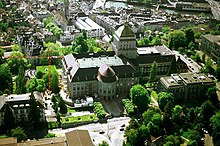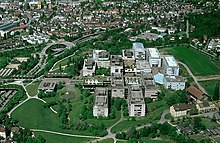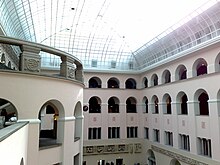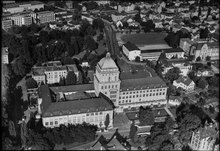University of Zurich
| University of Zurich | |
|---|---|

|
|
| founding | 1833 (legal predecessor: 1525) |
| Sponsorship | Canton Zurich |
| location | Zurich |
| country |
|
| Rector | Michael Schaepman |
| students | 25,217 (2017) |
| Employee | 9,246 (December 31, 2018) |
| including professors | 685 (December 31, 2018) |
| Annual budget | 1,377 million CHF (December 31, 2015) |
| Networks | IAU , IBH , LERU , Swissuniversities |
| Website | www.uzh.ch |
The University of Zurich ( UZH for short ) is a university in Zurich , in Switzerland . With over 25,000 students, it is currently the largest of all twelve Swiss universities . It was founded in 1833 and to date has been associated with a total of thirteen Nobel Prize winners .
As a full university , it unites all classical faculties under one roof: theology (ThF), law (RWF), economics (WWF), medicine (MeF), veterinary medicine (VSF), philosophy (PhF; the philosophy faculty is with around 47 percent of all students the largest faculty) and Mathematics - Natural Sciences (MNF).
The main building of the university, completed in 1914, is located at the foot of the Zürichberg , right next to the headquarters of the ETH Zurich .
overview


In addition to its own facilities, the University of Zurich also offers access to the archives, libraries and institutes of the ETH Zurich as well as private institutions. In addition, a number of museums and collections within the city of Zurich, from anthropology to zoology, are affiliated with the university, including the ethnological museum .
The University of Zurich is known for research successes in molecular biology , brain research and anthropology , for the activities of the Psychiatric University Clinic Zurich , the university and animal hospital, and for its efforts to improve the quality of teaching - for example through the use of e-learning . to continuously improve.
The university is part of the League of European Research Universities (LERU) and the International Lake Constance University .
story
founding
In 1832 the government council of the canton of Zurich decided to found a university in Zurich. The founding ceremony was on April 29, 1833. The already existing high schools for theology (since 1525), law and medicine were combined with a newly founded philosophy faculty to form the Universitas Turicensis . It was the first university in Europe to be founded by a democratic state and not by the church or a sovereign. It was founded almost four hundred years after the first university in Switzerland in Basel (1460), which in turn was brought into being by a papal bull before the Reformation .
The seal of the university shows the Grossmünster with Charlemagne and thus refers to the oldest secondary school in Zurich, the Collegium Carolinum .
The first seat of the university was in 1835 in the converted "rear office" of the former Augustinian monastery . In the first semester, 161 students were enrolled (16 theology, 26 law, 98 medicine and 21 philosophy), who were taught by 26 professors and 29 private lecturers. The first women were admitted to the Philosophical Faculty as early as 1840. The University of Zurich thus took on a pioneering role in terms of women's studies in the German-speaking area . In 1859 the Philosophical Faculty was split into two departments, one with a philosophical, linguistic and historical orientation (phil. I) and one with a mathematical and natural science department (phil. II).
In the polytechnic
In 1864 the university moved to the south wing of the newly built polytechnic due to lack of space . In 1867, Nadezhda Suslowa (1843–1918) became the first woman in the German-speaking world to receive a doctorate from the medical faculty of the University of Zurich; Marie Heim-Vögtlin (1845–1916) was the first Swiss woman to study medicine at the University of Zurich, who completed her doctorate in 1874 and founded the first Swiss women's hospital in 1889 with the affiliated “Pflägi” (1901).
In 1883, fifty years after it was founded, 91 lecturers (37 of them full professors) looked after 463 students. In 1901 the veterinary faculty was founded. Together with that of the University of Bern , it is considered the oldest veterinary medical faculty in the world.
In 1908, a segregation agreement between the canton of Zurich and the federal government regulated the ownership structure between the university and the ETH. This made it possible to merge joint institutes and collections. In the same year, the city and canton of Zurich approved a new building for the university in a referendum.
From 1909 Albert Einstein worked for two years as a lecturer in theoretical physics at the University of Zurich.
Main building Rämistrasse
In 1914 the university moved into its new main building on Rämistrasse . In 1908, voters in the city and canton of Zurich approved the new building and the necessary credit in a referendum. In 1917 the Zurich Central Library was opened, which is also the city, canton and university library .
In 1933, a hundred years after it was founded, the University of Zurich had 2,033 students.
In 1946, Winston Churchill gave his famous speech to the world's academic youth in the auditorium of the University of Zurich. The speech culminated in the well-known appeal to Europe: "Therefore I say to you: let Europe arise!"
University of Zurich-Irchel
Since the 1950s, the number of students has increased dramatically and space has become increasingly scarce. In 1962, the science faculty proposed moving part of the university to the north of the city. In 1973, construction work began on the University of Zurich-Irchel, which was inaugurated in 1979 (see also: Irchelpark ).
In 1983, one hundred and fifty years after it was founded, the University of Zurich had 15,000 students. In 1984 the university management was expanded by upgrading the rectorate to a main office and creating two vice-rectorships. In 1992 the law and political science faculties were split up into a law and an economics faculty.
In 2016, a medical chair dedicated entirely to breast milk research was created at the University of Zurich. It is the first of its kind in the world.
New university law
In 1998, the electorate in the Canton of Zurich approved the new University Act. The University of Zurich was thus granted the status of an independent legal personality. Since then, it has been able to dispose of its own financial resources and organize itself independently within a global budget .
2004 by the architect was Santiago Calatrava planned library of the Law Institute opened.
In 2008 the university celebrated its 175th anniversary.
On October 10, 2009, the foreign ministers of Armenia and Turkey signed a protocol brokered by Switzerland for the establishment of diplomatic relations at the University of Zurich. Federal Councilor Micheline Calmy-Rey , the American Foreign Minister Hillary Clinton , the Russian Foreign Minister Sergei Lavrov , the French Foreign Minister Bernard Kouchner , the Slovenian Foreign Minister and President of the Committee of Ministers of the Council of Europe Samuel Žbogar and the Secretary General of the Council of the European Union Javier Solana attended the ceremony.
In the fall semester of 2009, more than 25,000 students were enrolled for the first time. In August 2010, the Faculty of Economics at the University of Zurich was awarded the American AACSB seal of approval. The University of Zurich is the only German-speaking university, along with the University of St. Gallen and the University of Mannheim, to be accredited by both EQUIS and AACSB .
At the beginning of 2011, the economic faculty was reorganized. The former eight institutes have been merged into four new institutes (the name of the institute director in brackets): Business Administration (Dieter Pfaff), Economics ( Ernst Fehr ), Banking and Finance ( Thorsten Hens ) and Computer Science (Martin Glinz).
The students of the University of Zurich have been organized by law in the Union of Students of the University of Zurich since October 1, 2012 .
Public disputes
Since autumn 2012, there have been public disputes in connection with the dismissal of the curator of the Medical History Museum Christoph Mörgeli in the Mörgeli case , with another dismissal at the end of October 2013. On October 29, 2013, the dismissal of Iris Ritzmann , the deputy director of the Medical History Institute at the University of Zurich, became known. As a result of this criticism, Andreas Fischer announced his immediate resignation as rector of the university on November 6, 2013. The molecular biologist Michael Hengartner was elected as his successor in June 2013 . He took up his post early on February 1, 2014, and in the meantime, Vice-Rector Otfried Jarren was in charge of the university on an interim basis.
After the university put a filter into operation in February 2014 that was supposed to make access to pornographic Internet content more difficult, the Chaos Computer Club Zurich openly criticized the University of Zurich for the first time for its practice of network censorship and accused it of "inability to deal with cyberspace" before. As a result, the university largely withdrew the measure and set up a working group.
Faculties
- Faculty of Mathematics and Natural Sciences
- Medical school
- Philosophical Faculty
- Faculty of Law ( list of chair holders )
- Faculty of Theology
- Vetsuisse Faculty
- Faculty of Business and Economics
Rankings
The entire university was rated in the following two rankings, with the University of Zurich ranking 26th in Europe and 85th worldwide in the Times Higher Education World Universities Ranking . Newsweek rated the University of Zurich 11th in Europe and 46th in the world. In 2017, the University of Zurich was ranked 73rd in the QS ranking .
- Ranking of the Faculty of Business and Economics
The Economics Faculty of the University of Zurich was rated the best in the German-speaking area by the Handelsblatt in 2009 . The business administration faculty achieved fourth place in the German-speaking area. In a European comparison, the economics faculty ranks third in terms of research output behind the London School of Economics and University College London. The declared aim is to join the top international group.
Nobel Prize Winner
The university has a number of Nobel Prize winners who have received their doctorates or taught here:
- Rolf M. Zinkernagel , 1996 Nobel Prize in Medicine (Australian National University)
- Karl Alex Müller , 1987 Nobel Prize in Physics (IBM)
- Walter Rudolf Hess , 1949 Nobel Prize for Medicine
- Lavoslav Ružička , 1939 Nobel Prize in Chemistry
- Paul Karrer , 1937 Nobel Prize in Chemistry
- Peter Debye , 1936 Nobel Prize in Chemistry
- Erwin Schrödinger , 1933 Nobel Prize in Physics
- Albert Einstein , 1921 Nobel Prize in Physics
- Max von Laue , 1914 Nobel Prize in Physics
- Alfred Werner , 1913 Nobel Prize in Chemistry
- Theodor Mommsen , 1902 Nobel Prize for Literature
- Wilhelm Conrad Röntgen , 1901 first Nobel Prize winner for physics
Awards in teaching
- Medida-Prix 2000 for OLAT , Learning Management System, see http://www.olat.org/
- Medida-Prix 2002 for Ad fontes (learning program) , learning program for studying the sources in the archive, see http://www.adfontes.unizh.ch/
- German educational software award digita 2004, for Ad fontes
- University of Zurich project wins Medida-Prix 2006 2006 for eCF get involved in corporate finance course on the learning management system OLAT
See also
- List of the rectors of the University of Zurich
- List of collections and museums at the University of Zurich
- List of student associations in Zurich
- List of modern universities in Europe (1801–1945)
- Zurich poetry lectures
literature
- Sebastian Brändli: University of Zurich. In: Historical Lexicon of Switzerland .
- Georg von Wyss: The Zurich University of Applied Sciences in the years 1833–1883: Festschrift for the 50th anniversary of its foundation. Zurich 1883.
- University of Zurich: Commemorative publication of the government council on the inauguration of the new buildings April 18, 1914. Zurich 1883.
- Ernst Gagliardi , Hans Nabholz and Jean Stohl: The University of Zurich 1833–1933 and its predecessors: Festschrift for the celebration of the century. Zurich 1938.
- Peter Stadler : The University of Zurich 1933–1983: Festschrift for the 150th anniversary of the University of Zurich. Zurich 1983.
- Sarah Bolleter, Heini Ringger and others: Flashbacks, insights, outlooks - University of Zurich 2008: Sharing knowledge: 175 years of the University of Zurich. Zurich 2008.
- Michèle Jäggi: Zurich university building. ( Swiss Art Guide , No. 764/765, Series 77). Edited by the Society for Swiss Art History GSK. Bern 2005, ISBN 978-3-85782-764-8 .
- Art history seminar at the University of Zurich: Marco Crameri and others: University of Zurich. (Swiss Art Guide, No. 270, Series 27). Edited by the Society for Swiss Art History GSK. Bern 1980, ISBN 978-3-85782-270-4 .
- Verena Stadler-Labhart: «Parnassus is not in the Swiss Alps ...»: Aspects of Zurich university history: Articles from the «Zürcher Taschenbuch» 1939–1988. Zurich 1991.
- Else Forrer-Gutknecht: On the history of women's studies at the University of Zurich. Zurich 1928.
- Katharina Belser et al .: Just as new as bold: 120 years of women's studies at the University of Zurich. Zurich 1988.
- Hans Erb: History of the student body at the University of Zurich, 1833-1936. Zurich 1937.
- Student Council of the University of Zurich (Ed.): We are what we remember: on the history of the students at the University of Zurich from 1968 to 2008. Zurich 2008.
- Willy Meyer: The financial history of the University of Zurich from 1833 to 1933. Zurich 1940.
See also
Web links
- University of Zurich website
- Matriculation edition of the University of Zurich 1833–1923
- Historical course catalogs of the University of Zurich 1833–1900
- Annual reports of the University of Zurich
- UZH archive
- Report by the Education and Health Supervisory Commission on the investigations relating to the Medical History Institute and Museum of the University of Zurich. KR no. 127/2014. Cantonal Council of Zurich from June 5, 2014 (PDF file)
Individual evidence
- ↑ University management. In: University of Zurich. Retrieved August 3, 2020 .
- ↑ University of Zurich Annual Report 2017
- ↑ a b University of Zurich: Personal data 2018 (PDF)
- ↑ University of Zurich Annual Report 2015, p. 5
- ^ List of IAU Members. In: iau-aiu.net. International Association of Universities, accessed August 18, 2019 .
- ^ Members. In: www.swissuniversities.ch. swissuniversities, 2019, accessed on August 31, 2019 .
- ^ Sebastian Brändli: University of Zurich. In: Historical Lexicon of Switzerland . January 28, 2013 , accessed March 1, 2020 .
- ^ University. Retrieved February 26, 2021 .
- ↑ Johann Jacob Wirz: Historical representation of the documented ordinances: which concern the history of the church and school system in Zurich as well as the moral and, to some extent, the physical species of our people. Zurich 1793, p. 217.
- ^ University of Zurich: History
- ↑ The world's first chair for breast milk research In: Hamburger Abendblatt from July 8, 2015, accessed on July 10, 2015
- ↑ Sharing knowledge - 175 years of the University of Zurich
- ↑ More than 25,000 students at the University of Zurich. ( Memento of September 11, 2009 in the Internet Archive ), press release of September 8, 2009
- ↑ Most of the new students at UZH are starting a business degree ( memento from December 19, 2009 in the Internet Archive ), press release from December 15, 2009
- ↑ The UZH's coveted seal of approval for economics ( memento from August 19, 2010 in the Internet Archive ), press release from August 3, 2010
- ^ Reorganization of the Faculty of Business and Economics ( Memento from November 10, 2013 in the Internet Archive ), February 21, 2011
- ↑ Walter Bernet: The university can no longer score. In: Neue Zürcher Zeitung from October 31, 2013
- ↑ Pascal Hollenstein: Uprising of the professors. In: NZZ am Sonntag of November 3, 2013
- ^ Mörgeli case: Rector of the University of Zurich resigns. In: tagesanzeiger.ch , November 6, 2013, accessed on February 9, 2019.
- ^ Mörgeli case: What happens after the rector resigns. In: Tages-Anzeiger .ch / Newsnet of November 11, 2013
- ↑ Hackers criticize the University of Zurich's web filter: “Inability to deal with cyberspace” In: NZZ of March 14, 2014
- ↑ University of Zurich limits internet access. In: NZZ of March 26, 2014
- ^ QS World University Rankings - topuniversities.com , accessed on Feb. 14, 2018
- ↑ Gesellschaft für Marketing: Handelsblatt Ranking: Uni Zurich in 1st place (Economics) and Uni St. Gallen in 2nd place (Business Administration) ( Memento from July 28, 2009 in the Internet Archive )
- ↑ Handelsblatt Ranking Business Administration 2009 - Handelsblatt Online
- ↑ University of Zurich is top 3 Research Excellence Center of Economics in Europe ( Memento from February 13, 2011 in the Internet Archive )
- ^ University of Zurich - Nobel Prize Winner
Coordinates: 47 ° 22 '29 " N , 8 ° 32' 54" E ; CH1903: 683808 / 247691







